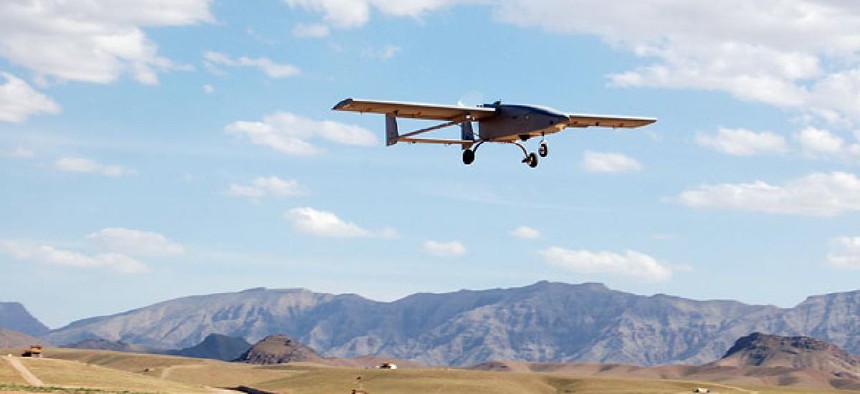Analysis: Taking bots into battle
As unmanned systems advance, do humans have to remain in the loop?
Something you probably didn’t know -- even if you devoured P.W. Singer’s Wired for War in hardback a few years ago or more recently read Eric Schmitt and Thom Shanker’s Counterstrike on your Kindle or Nook -- the days of “one person, one vehicle, one joystick,” even in remotely piloted aircraft, are numbered. Remotely piloted vehicles like those operated from Creech Air Force Base in Nevada and flying over Afghanistan are only near-term solutions to long-term threats.
But what comes after today’s Reapers and Predators in the military and intelligence agency fleets is fraught with even more ethical concerns than the CIA targeting suspected terrorists in Yemen and Haqqani Network sites in Waziristan.
Unmanned systems -- air, ground, sea and underwater -- are among the exceptions in the Defense Department’s fiscal 2013 budget request. Instead of going down, funding slated for these programs is rising by $3.8 billion. Even the Pentagon’s research, development, test and evaluation budget request is up from $971 million to $1.1 billion.
This is a far cry from the shotgun blast into the ceiling from former Sen. John Warner, R-Va., before the Sept. 11, 2001, terrorist attacks, when he called on the military services to buy more unmanned systems because the American public had no tolerance for American war casualties. Warner’s goal was for drones to comprise one-third of all U.S. military aircraft, ground vehicles and surface and underwater vessels within a decade.
Rough seas and communication difficulties literally are slowing the push for unmanned vessels on and below the surface. But in the air, about 40 percent of the Air Force’s fleet is unmanned. And ground bots are working tirelessly to spot roadside bombs and scout out rooms before soldiers move about in Afghanistan.
The overriding question is: As artificial intelligence advances, do humans have to remain in the loop?
As Norman Friedman, author of Unmanned Air Combat Systems: A New Kind of Carrier Aviation (Naval Institute Press, 2010), puts it, “People cost a lot of money. In the air world, the most expensive item is the pilot.” According to Friedman, you’re paying for the pilot’s judgment in targeting and firing, not just launching a cruise missile toward a predetermined target. Judgment is going to matter even more because potential enemies are “not wearing uniforms and [driving] vehicles that say ‘I’m the enemy,’ ” he argues.
Lt. Col. Thomas Rempfer, flight commander for the 2nd Special Operations Squadron at Nellis Air Force Base in Nevada, swears by his unit’s Predator operations. “There was no way when I was flying A-10s or F-16s that I could connect with the guys on the ground” from command centers to truck drivers in convoys, he says. “We’re more in the loop flying remotely piloted vehicles. The platform and operator are continuously engaged.”
But the golden age of unmanned aerial systems has not yet arrived, Col. Timothy Healy, chief of the Mission Command and Awareness Division at the Army’s Training and Doctrine Command, said at a Joint Warfighting Conference in Virginia Beach, Va. In addition to devouring bandwidth to support a network transmitting high-definition images to someone on the ground while soldiers are on the move, the Army should ask itself whether lower-level commanders really need all this information, Healy said.
There is a safety concern when field commanders launch 10- to 15-pound UAVs into the same airspace where the OH-58 Kiowa Warrior, an armed reconnaissance helicopter, and UH-60 Blackhawk, are used to carry or medevac soldiers.
Occupying the same airspace is an increasing reality, and the Army is experimenting with teaming unmanned Shadow 200s with Kiowa Warriors. “They are all part of one organization, getting the same mission briefing, picking each other’s brain,” Healy said.
How effective will teaming be? The Army has taken tentative steps using Block III AH-64 Apache attack helicopters and a variety of unmanned aerial vehicles. Since 1997, Boeing, the manufacturer of the Apache, has worked on teaming, starting with its Longbow version. But, Healy said, “it all goes back to the bandwidth issue.”
The Joint Staff is thinking slightly differently as it tries to adapt the armed forces to a world of tight economics.
“It’s easy to move people. Hard to move equipment,” Lt. Gen. George Flynn, USMC, director J-7 Joint Staff, said at the conference, and that probably spells deeper cuts in the Army’s heavy forces and a greater reliance on unmanned systems.
Eliminating tanks, fighting vehicles and other heavy equipment means rethinking the future force structure. “Why are we keeping people in the loop?” Flynn said, noting that unmanned systems “have huge upside potential.” Think Predators vs. U-2s -- both capable of staying aloft 24 hours but a human pilot is only viable for nine hours. Also, information technology advances make it possible to modify and improve unmanned systems every 18 months at a relatively low cost. Upgrading Predators from analog to digital systems, for example, cost the Pentagon $300 million, and the program was complete in six months.
“We have to be platform-agnostic,” said retired Marine Corps Gen. James Cartwright, former vice chairman of the Joint Chiefs of Staff, noting the Pentagon soon will field the F-35 Joint Strike Fighter at a price tag of more than $200 million per plane, but it will be vulnerable to cyberattacks and [lasers] that move at the speed of light. “There is a nexus coming between electronics and cyber” that puts even greater emphasis on unmanned systems.
He describes their value this way: “One knocks the door down and the other goes in and does the dirty work . . . The offense always has the advantage.”
Clarification: This story has been updated to clarify the percentage of unmanned vehicles in the Air Force’s fleet.
John Grady, retired director of communications for the Association of the United States Army, writes about defense and national security for various organizations and publications.
NEXT STORY: Does Telework Work?




